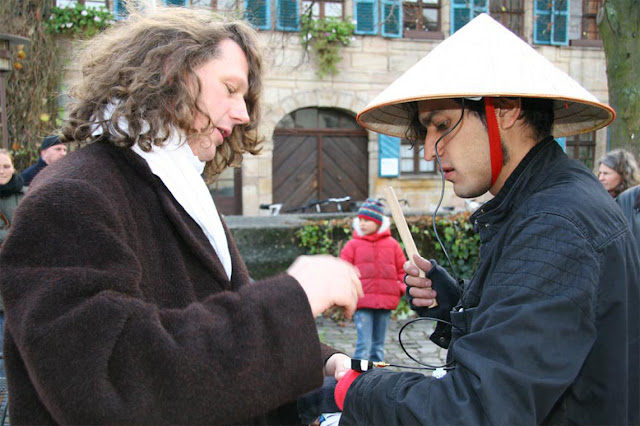ART SPACE MUSIC
a collective soundscape for any art space
ECHOING SHANGHAI
Ambient Sound Art / Unplugged Media Art
As a child, I thought if I dug a tunnel through the earth at which I was standing, I would simply pop up in China, because it was apparently on the other side of the earth at the place where I was standing. Fascinated with sound and seeking a simpler solution than digging, I thought of a more practical solution similar to pre radar times: Sound travels, so if I put my ear to the ground, I would simply hear the Chinese talking. Experimenting, I believed it to be true, but instead of Chairman Moa giving speeches, it was my downstairs neighbor’s television playing the evening news. Sound is made up of waves that radiate into infinity and it does not really matter whether one can hear the Chinese or not, because we can imagine that one can hear a very small percent of what they are talking about and discover the world of hidden sounds while doing so. Using the custom made “Listening Sticks” that act as acoustic aids, the installation “Echoes of Shanghai” lets one discover the “other side of things”: The wonderful world of daily life in Shanghai streets and how it is so portrayed in sound, even if it might be just a faint echo of it all: The taxi drivers honking, the bicycle peddlers ringing their bells, fake market people, and the endless sounds of all those people talking, shouting and singing.
GOINGPUBLIK
music for a distributed ensemble & wearable computers
The core idea behind the work is a strategy of mobility by employing a wearable computer system running a software based electronic scoring system. The score allows for ‘composed improvisation’ that is improvisational elements within a compositional structure. This is done by electronically monitoring the performer’s physical position in space using universal inputs such as geographical positions obtained via satellites and sensors using the earth’s magnetic field. These are used to guide the score program in making suggestions to the performer to various degrees and at various times. The contents of the score are thereby linked directly to the movements of the performer, thus creating a unique choreographic metaphor of sound dispersing in space. Compositional quantities and qualities are based on spatial mobility and intensity of form being defined by changes in timbre, rhythmic modulations and distribution of sound. There are two version of the work: One version is for closed performance spaces and uses a GPS simulator to virtually walk through the city without leaving the performance space; the other version uses satellites as a globally embedded sensor environment. Both versions network the performers in such a manner that the electronic scoring becomes self-regulating, or truly ‚ubiquitous’ so that the performers are ‚hands free’ and able to react to ensemble members and to interact with the performance space.
LOVE GAS
public sound art for 100 motorcycles & conductor
Love Gas is not only a performance with a sound composition as conceptual base, but it is also an art spectacle for the whole family. It is a conducted piece conceived to be receptive to a diverse group of motorcycle riders, so that they, as sporty non-intellectuals, might develop a different idea of modern art and music. From zero to one hundred in 10 seconds is understood by any rider as is the use of the horn at busy intersections, idiot car drivers etc. The piece is best understood as a performative sound collage. It isn’t notated for a trained eye reacting to complex symbolic gestures in a studied and virtuosic way, but is interpreted through a gestural notation system similar to the sign languages used by the deaf. All of the gestures used refer either to the motor indicative of rpm level and durational values, or for the horn indicative of durational values. The composition has duration of 60 minutes. Within this time period, the harmonic palette of one-hundred similarly tuned motors of the same make and size is explored as presented in the form of a higher art music.
GONG.PONG.SAT
mobile sound art for gongs, pubic & satellites
The work Gong.Pong.SAT is technically based on possibilities of synchronising a group of performers using the clock pulses emitted from GPS satellites. Aesthetically, the work is rooted in works for open public space and belongs to a series of works, which celebrate the use of innovative mobile technologies to explore public space and public audience. The performance takes place in a limited city area. A series of tuned gongs equal to the number of performers participating are used to perform the work. Tuned to an Eastern musical scale, these gongs give the piece a touch of the orient on the horizontal, or melodic side and a western type dissonance on the vertical, or chord structure side. To perform the piece, each player leaves a self-defined starting point wearing a custom built GPS interface (Wrist-Conductor) on the wrist, which interface acts as a ‚conductor’, indicating when the gong is to be hit. By using a delay between the satellite clock pulse and the LED that indicates when to strike the gong, a ‚harmolodic’ effect is obtained as the players gradually shift from a chordal to a melodic structure dependent on geographical coordinates. Player’s movements combine into a “choreographic counterpoint”, which bring about a rhythmic-melodic coloring caused by the vertical to horizontal unfolding of the struck gong chord.




